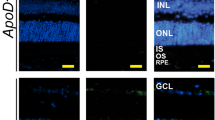Abstract
Some humans and animals with inherited retinal degenerations (RD) have lower blood levels of docosahexaenoic acid (22:6n-3) than controls. As a result of recent studies, clearly the low blood 22:6n-3 phenotype is found in multiple RD phenotypes and no mutation thus far identified in humans or animals is involved in lipid metabolism. Therefore, it seems reasonable to suggest that the primary defect is not in 22:6n-3 metabolism, but rather in some common convergent pathway that ultimately leads to the reduction of blood and tissue 22:6n-3 levels. One possibility is that the different mutations produce a metabolic stress that provokes structural and biochemical adaptive changes in photoreceptor cells and their rod outer segments. If the stress is oxidant, the retina could downregulate 22:6n-3 and upregulate antioxidant defenses. How such a stress could lead to changes in blood levels of 22:6n-3 is not obvious. However, the consistent finding of the 22:6n-3 phenotype in many different retinal degeneration genotypes suggests that some form of communication exists between the retina and other tissues that serves to reduce blood levels of 22:6n-3.
Similar content being viewed by others
Abbreviations
- LCPUFA:
-
long-chain polyunsaturated fatty acids
- RD:
-
retinal degeneration
- ROS:
-
rod outer segment
- RP:
-
retinitis pigmentosa
References
Converse, C., Hammer, H., Packard, C., and Shepherd, J. (1983) Plasma Lipid Abnormalities in Retinitis Pigmentosa and Related Conditions,Trans. Ophthalmol. Sci. UK 103, 508–512.
Converse, C., McLachlan, T., Bow, A., Packard, C., and Shepherd, J. (1987). Lipid Metabolism in Retinitis Pigmentosa, inDegenerative Retinal Disorders, Clinical and Laboratory Investigations (Hollyfield, J., Anderson, R., and LaVail, M., eds.) pp. 93–101, Alan R. Liss Inc., New York.
Anderson, R., Maude, M., Lewis, R., Newsome, D., and Fishman, G. (1987) Abnormal Plasma Levels of Polyunsaturated Fatty Acid in Autosomal Dominant Retinitis Pigmentosa,Exp. Eye Res. 44, 155–159.
Gong, J., Rosner, B., Rees, D., Berson, E., Weigel-DiFranco, C., and Schaefer, E. (1992) Plasma Docosahexaenoic Acid Levels in Various Genetic Forms of Retinitis Pigmentosa,Invest. Ophthalmol. Vis. Sci. 33, 2596–2602.
Hoffman, D., Uauy, R., and Birch, D. (1993) Red Blood Cell Fatty Acid Levels in Patients with Autosomal Dominant Retinitis Pigmentosa,Exp. Eye. Res. 57, 359–368.
Holman, R., Bibus, D., Jeffrey, G., Smethurst, P., and Crofts, J. (1994) Abnormal Plasma Lipids of Patients with Retinitis Pigmentosa,Lipids 29, 61–65.
Hoffman, D., and Birch, D. (1995) Docosahexaenoic Acid in Red Blood Cells of Patients with X-linked Retinitis Pigmentosa,Invest. Ophthalmol. Vis. Sci. 36, 1009–1018.
Bazan, N., Scott, B., Reddy, T., and Pelias, M. (1986) Decreased Content of Docosahexaenoate and Arachidonate in Plasma Phospholipids in Usher’s Syndrome,Biochem. Biophys. Res. Comm. 141, 600–604.
Maude, M.B., Anderson, E.O., and Anderson, R.E. (1998) Polyunsaturated Fatty Acids Are Lower in Blood Lipids of Usher’s Type I, but Not Usher’s Type II,Invest. Ophthalmol. Vis. Sci. 39, 2164–2166.
Anderson, R., Maude, M., Alvarez, R., Acland, G., and Aguirre, G. (1991) Plasma Lipid Abnormalities in the Miniature Poodle with Progressive Rod-Cone Degeneration,Exp. Eye Res. 52, 349–355.
Aguirre, G., Alligood, J., O’Brien, P., and Buyukmichi, N. (1982) Pathogenesis of Progressive Rod-Cone Degeneration in Miniature Poodles,Invest. Ophthalmol. Vis. Sci. 23, 610–630.
Aguirre, G., Acland, G., Maude, M., and Anderson, R. (1997) Diets Enriched in Docosahexaenoic Acid Fail to Correct Progressive Rod-Cone Degeneration (prcd) Phenotype,Invest. Ophthalmol. Vis. Sci. 38, 2387–2407.
Alvarez, R., Aguirre, G., Acland, G., and Anderson, R. (1994) Docosapentaenoic Acid Is Converted to Docosahexaenoic Acid in the Retinas of Normal andprcd-Affected Miniature Poodle Dogs,Invest. Ophthalmol. Vis. Sci. 35, 402–408.
Anderson, R., and Maude, M. (1972) Lipids of Ocular Tissues: VII. The Effects of Essential Fatty Acid Deficiency on the Phospholipids of the Photoreceptor Membranes of Rat Retina,Arch. Biochem. Biophys. 151, 270–276.
Wiegand, R., Koutz, C., Chen, H., and Anderson, R. (1995) Effect of Dietary Fat and Environmental Lighting on the Phospholipid Molecular Species of Rat Photoreceptor Membranes,Exp. Eye Res. 60, 291–306.
Neuringer, M., Connor, W., Van Patten, C., and Barstad, L. (1984) Dietary Omega-3 Fatty Acid Deficiency and Visual Loss in Infant Rhesus Monkeys,J. Clin. Invest. 73, 272–276.
Neuringer, M., Connor, W., Lin, D., Barstad, L., and Luck, S. (1986) Biochemical and Functional Effects of Prenatal and Postnatal θ3 Fatty Acid Deficiency on Retina and Brain in Rhesus Monkeys,Proc. Natl. Acad. Sci. USA 83, 4021–4025.
Weisinger, H., Vingrys, A., and Sinclair, A. (1996) Effect of Dietary n-3 Deficiency on the Electroretinogram in the Guinea Pig,Ann. Nutr. Metab. 40, 91–98.
Weisinger, H., Vingrys, A., and Sinclair, A. (1996) The Effect of Docosahexaenoic Acid on the Electroretinogram of the Guinea Pig,Lipids 31, 65–70.
Galli, C., Trzeciak, H., and Paoletti, R. (1971) Effects of Dietary Fatty Acids on the Fatty Acid Composition of the Brain Ethanolamine Phosphoglyceride: Reciprocal Replacement of n-6 and n-3 Polyunsaturated Fatty Acids,Biochim. Biophys. Acta 248, 449–454.
Penn, J., and Anderson, R. (1987) Effect of Light History on Rod Outer-Segment Membrane Composition in the Rat,Exp. Eye Res. 44, 767–778.
Penn, J., Naash, M., and Anderson, R. (1987) Effect of Light History on Retinal Antioxidants and Light Damage Susceptibility in the Rat,Exp. Eye Res. 44, 779–788.
Penn, J., and Anderson, R. (1992) Effects of Light History on the Rat Retina, inProgress in Retinal Research (Osborne, N., and Chader, G., eds.) pp. 75–98, Pergamon Press, New York.
Penn, J., Thum, L., and Naash, M. (1989) Photoreceptor Physiology in the Rat Is Governed by the Light Environment,Exp. Eye Res. 49, 205–215.
Bazan, N.G., and Rodriguez de Turco, E.B. (1996) Alterations in Plasma Lipoproteins and DHA Transport in Progressive Rod-cone Degeneration (prcd) inRetinal Degeneration and Regeneration (Kato, S., Osborne, N.N., and Tamai, M. eds.) pp. 89–97, Kugler Publications, Amsterdam.
Author information
Authors and Affiliations
Corresponding author
About this article
Cite this article
Anderson, R.E., Maude, M.B., Alvarez, R.A. et al. A hypothesis to explain the reduced blood levels of docosahexaenoic acid in inherited retinal degenerations caused by mutations in genes encoding retina-specific proteins. Lipids 34 (Suppl 1), S235–S237 (1999). https://doi.org/10.1007/BF02562304
Issue Date:
DOI: https://doi.org/10.1007/BF02562304




